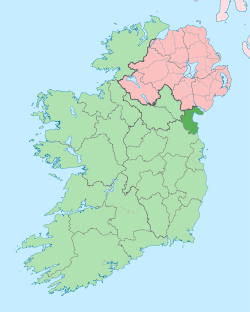Annagassan
Annagassan (Irish: Áth na gCasán, meaning "ford of the paths")[2] is a village in the townland of Ballynagassan, County Louth, Ireland. It sits where the River Glyde enters the Irish Sea.
Annagassan Áth na gCasán | |
|---|---|
Village | |
 Annagassan bridge | |
 Annagassan Location in Ireland | |
| Coordinates: 53°53′N 6°21′W | |
| Country | Ireland |
| Province | Leinster |
| County | County Louth |
| Population (2016)[1] | 201 |
History
Annagassan was first mentioned as Linn Duachaill in AD 841 when the establishment of a Viking longphort was recorded.[3] This has subsequently been confirmed by archaeological work.[4][5]
In 827 the Annals of Ulster record that the Vikings attacked the Ciannachta people of Louth and north Meath. These early raids were sporadic coastal attacks by small seaborne forces; however, from the 830s, a new phase was characterised by larger fleets, which penetrated up navigable rivers and plundered extensive inland areas. There is a legend that one such Viking was stranded after a raid and settled there. The locals believe this Viking heritage is evidenced by the long-held residence of a seafaring man of "mythic proportions" and wild Scandinavian appearance and demeanour, known to the villagers as "The Bear".
Annagassan was once as important as the Viking settlement at Dubh Linn (The Black Pool).[5] The modern village is generally believed to be built on what archaeologists consider to be a man-made polder structure, constructed to provide shelter for the fjord. The original settlement was located further upstream; navigation was considerably easier on the River Glyde in the 9th century before the intervening build-up of sediment.
Transport

Bus Éireann route 168 provides two journeys to Dundalk Mondays to Fridays inclusive and a solitary return journey from Dundalk. The morning outward journey and the return journey serve Dromiskin.[6]
References
- "Sapmap Area - Settlements - Annagassan". Census 2016. Central Statistics Office. April 2016. Retrieved 5 February 2020.
- "Annagassan" A Dictionary of British Place-Names. A. D. Mills. Oxford University Press, 2003. Oxford Reference Online. Oxford University Press. Solihull Libraries. 16 April 2008
- Connolly S.J (1998). The Oxford Companion to Irish History. Oxford University Press. p. 580. ISBN 0-19-211695-9.
- Keogh, Elaine (10 October 2011). "Unlocking the past: mythical Viking village really exists". Independent.ie. Retrieved 27 October 2011.
- Macauley, Conor (24 October 2011). "Linn Duchaill: Ireland's unlikely Viking capital". BBC News. Retrieved 27 October 2011.
- "Archived copy" (PDF). Archived from the original (PDF) on 20 December 2011. Retrieved 28 December 2011.CS1 maint: archived copy as title (link)
